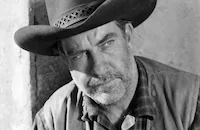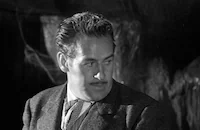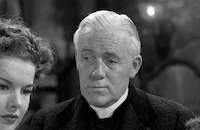The Fighting Seabees

Brief Synopsis
Cast & Crew
Edward Ludwig
John Wayne
Susan Hayward
Dennis O'keefe
William Frawley
Leonid Kinskey
Film Details
Technical Specs

Synopsis
Egotistical, hard-working Wedge Donovan, the owner of a highly reputed construction company, greets members of his crew as they return from a job for the Navy. Wedge is infuriated to learn that the men, who were working on a South Pacific island, were targeted by Japanese forces because technicians are irreplaceable. As civilians, the workers could not be armed and sustained heavy losses. Wedge lambasts Lt. Cmdr. Bob Yarrow, who was in charge of the mission, but is surprised when Bob agrees that the situation must be corrected. Bob invites Wedge to accompany him to Washington, D.C. and approach Capt. Joyce about establishing a construction battalion. In Washington, Wedge is enthusiastic until he learns that it will take months of military training before his men can be armed. Fed up with what he perceives as Navy red tape, Wedge says that his men will fend for themselves and storms out. Wedge then accompanies his crew to another small island in the South Pacific, where they are to build an air field. Also along is a group of war correspondents, including Constance Chesley, who is strongly attracted to Wedge, despite her romantic attachment to Bob. Wedge fights his own feeling for Connie, telling her to "stick with the guy who brought her." Wedge continually balks at Bob's strict Navy methods, so Connie tries to win him over with kindness, and the construction work progresses rapidly. One afternoon, however, an air raid siren sounds, and three of Wedge's men are shot by Japanese airplanes as they stand outside the bomb shelter. Believing that the Navy men have left them to be mowed down, Wedge and his crew grab guns and rush out to join the battle. They blunder into a trap that Bob and the soldiers have laid for the approaching Japanese forces, however, and the ensuing battle takes a heavy toll on the men, although the Navy eventually repels the invaders. Connie is shot by a wounded Japanese soldier as she runs on the beach, and before she passes out, she and Wedge declare their love for each other. Having heard the exchange, Bob questions Wedge, who asserts that he spoke only to comfort the wounded Connie. Wedge then attends to his injured men and can offer no resistance when Bob blames him for the damage. Bob still wants Wedge to help him press for the armed construction battalions though, and the reformed Wedge accepts a Navy commission and works alongside Bob. Later, after the workers have enlisted in the Navy and undergone rigorous military training, four platoons of the new Construction Battalions, nicknamed the Seabees, stand ready for duty. On the night before Bob and Wedge are to ship out, Connie returns to Washington, and Wedge tells her that she should stick with Bob. Although she is crushed by the rejection, Connie responds warmly when Bob confesses that he still loves her. Later, the Seabees return to the South Pacific, where they are to build a crucial oil depot. The work moves swiftly despite interference from Japanese snipers, and soon construction is complete. Eddie Powers, Wedge's foreman, is shot and killed as he opens the first oil valve, however, and an infuriated Wedge orders his men into the jungle to search for snipers. Bob receives a report of encroaching fog and, afraid that Japanese surface craft will slip in, goes to warn Wedge. While Bob is discovering that Wedge has abandoned his post to go into the jungle, a battle begins nearby. Airplanes from closely positioned U.S. battleships land for refueling, while anti-aircraft guns fight incoming Japanese planes. Japanese troops move onto the island, and Bob is wounded during a fierce gun battle. Wedge returns and reports to Bob, who wearily tells him that he will probably be court-martialed upon their return home. Bob then orders Wedge to protect the oil tanks at any cost, and Wedge's men spring into action. With the Japanese forces split into two columns, Wedge is forced to send his men after one side, while he attaches a bomb to a bulldozer and heads for the oil fields, where he intends to ignite one tank and spill the flaming oil onto the other enemy column. Wedge is mortally wounded but carries out his mission, and soon the enemy soldiers are routed. Later, back in the United States, Connie watches with pride as Bob announces to the assembled men that the President has issued a citation to commend the Seabees' courage under fire. Bob and Connie then embrace, and although Connie admits that the brave Wedge held a special place in her heart, she says that she has always loved Bob the most.

Director

Edward Ludwig
Cast

John Wayne

Susan Hayward

Dennis O'keefe

William Frawley

Leonid Kinskey

J. M. Kerrigan

Grant Withers

Paul Fix
Ben Welden
William Forrest

Addison Richards
Jay Norris
Duncan Renaldo
Charles Sullivan
Joey Ray
Al Murphy
Bud Geary
Abdullah Abbas
Chief Thundercloud

Gene Gary
William Hall

Roy Barcroft
Jean Fenwick
Charles Trowbridge
Nora Lane
Tom London
Leroy Mason

Adele Mara
Ernest Golm
Clarence Straight
Roy Darmour
Billy Wayne
Herbert Heyes
Forbes Murray
Frank Marlowe
Joel Allen
Terry Frost
Hugh Prosser
Paul Parry
Roy Brent
Jack Gardner

Charles D. Brown
Lee Adams
Robert Katcher
J. Alex Havier
James B. Leong
Jung Lim
Clarence Lung
John James
Charles Mitchell
Buddy Wilkerson
George Bruggeman
Charles Hayes
Ben Taggart
George Sherwood
Crane Whitley
Hal Taliaferro
Crew
Adele
William Bradford
Tom Carman
Borden Chase
Borden Chase
Albert J. Cohen
Duncan Cramer
Peter De Rose
Phil Ford
Ethel Hill
Lt. Comdr. Hubert Hunter Cec-v(s), Usnr
Russell Kimball
Sam M. Lewis
Bob Littlefield
Howard Lydecker
Theodore Lydecker
Aeneas Mackenzie
Charley Marks
Lt. Comdr. William A. Mcmanus (cec) Usn
Walter Scharf
Otto Siegel
Richard Van Enger
Dale Van Every
Harry Warren
Ned Washington
Mortimer Weinberg
Howard Wilson

Videos
Movie Clip


Film Details
Technical Specs

Award Nominations
Best Music, Original or Comedy Series
Articles
The Fighting Seabees
In The Fighting Seabees, they are a melting-pot group led by John Wayne and Dennis O'Keefe. Wayne is the no-nonsense head of a construction company, frustrated that the Navy won't arm his men, and O'Keefe is a Navy commander who finally convinces Wayne to agree to the lengthy military training necessary for that to happen. Together they return to the Pacific and engage in some truly flag-waving, action-packed combat. Romance is tossed in by means of Susan Hayward as a newspaper correspondent sent to the island; an inevitable love triangle forms.
The screenplay by Borden Chase and Aeneas MacKenzie moves right along - not a surprise given the talent of these two men. MacKenzie, for instance, also wrote the scripts They Died with Their Boots On (1941) and Reign of Terror (1949), while Chase would claim to his credit Red River (1948) and Winchester '73 (1950).
Director Edward Ludwig later said that when the company was in the South Pacific doing location work on The Fighting Seabees, some real servicemen picked fights with Wayne over the fact that he was not serving in the real WWII. It's true that Wayne was of legal draft age and never served, and in light of Wayne's strong and conservative support of patriotism and the military, it became a controversial element of his life. He had been getting draft deferments so he could keep making movies. Originally he was granted 3-A deferments because he had four kids; later that was changed to a 2-A deferment because it was determined to be in the greater national interest for him to be making movies than to be serving in the military. Wayne felt troubled by all this - after all, other actors like William Holden, James Stewart and Henry Fonda all had families and yet were serving. Nonetheless Wayne settled with the knowledge that his movies, and his participation in the USO, helped the war effort in their own way.
Susan Hayward had been under contract to Paramount since 1939 but had been stuck in secondary roles ever since. On loan to Republic Pictures, she finally won the female leads in Hit Parade of 1943 and The Fighting Seabees, after which true stardom came quickly. She would amass five Best Actress Oscar® nominations and win the award once (for I Want to Live!, 1958).
Some more tidbits: The Fighting Seabees is one of only seven movies in which John Wayne dies on screen, and it happens in a blaze of spectacular glory. Character actor Paul Fix, here playing Ding Jacobs, had been a friend of Wayne's since the mid-1930s when he coached Wayne on his screen acting. They would appear in 27 films together. Walter Scharf's score received an Oscar® nomination.
Producer: Albert J. Cohen
Director: Edward Ludwig
Screenplay: Borden Chase, Aeneas MacKenzie
Cinematography: William Bradford
Film Editing: Richard Van Enger
Art Direction: Duncan Cramer
Music: Peter De Rose, Sam Lewis
Cast: John Wayne (Lt. Cmdr. Wedge Donovan), Susan Hayward (Constance Chesley), Dennis O’Keefe (Lt. Cmdr. Robert Yarrow), William Frawley (Eddie Powers), Leonid Kinskey (Johnny Novasky), J.M. Kerrigan (Sawyer Collins).
BW-100m. Closed captioning.
by Jeremy Arnold

The Fighting Seabees
Quotes
Trivia
Notes
After the opening onscreen credits, a written prologue reads: "Proudly and gratefully we dedicate this picture to the Civil Engineer Corps and the Construction Battalions-the Seabees of the United States Navy who have fired the imagination of the world with their colorful exploits throughout the Seven Seas." The U.S. Navy Construction Battalions, known as the Seabees, was created in January 1942 to provide armed, militarily trained construction workers to erect buildings, airfields, refueling bases, etc. in support of the military during World War II. The motto of the tenacious Seabees, "We build, we fight," was echoed in the speech of "Lt. Comdr. Bob Yarrow" at the film's end, when he praises his men and states, "We build for the fighters, we fight for what we build."
Hollywood Reporter news items noted that George Reeves, who was to be borrowed from Paramount, was originally set to co-star in the film with John Wayne, but was prevented from appearing when he was drafted into the Army Air Corps. Susan Hayward was borrowed from Paramount for the production, which received full cooperation from the U.S. Navy, according to news items and reviews. Although a July 1943 Hollywood Reporter news item noted that the studio was "writing the character of Captain Needham, commanding officer of the Construction Battalions at Camp Hueneme, into the script...and Albert J. Cohen has wired for permission to have the captain play himself in the picture," Needham does not appear as a character in the completed film.
According to Hollywood Reporter news items, the parade ground scenes were shot on location at Camp Endicott, in Davisville, RI, and featured footage of real Seabees marching in review before the Secretary of the Navy. Other locations included Camp Huemene, near Santa Barbara, CA; Camp Pendleton, CA; and a camp in Virginia. Hollywood Reporter news items noted that the picture was to have its world premiere at all Seabee camps throughout the country on January 14, 1944, and that several "pre-release" showings were to be seen in different cities in January 1944. Five hundred 16mm prints of the picture were to be distributed to U.S. military camps throughout the world, according to a January Hollywood Reporter news item. The picture received an Academy Award nomination for Best Music Score.

Miscellaneous Notes
Released in United States Spring March 10, 1944
Released in United States Spring March 10, 1944













